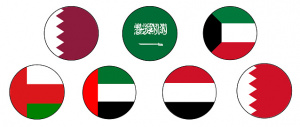Difference between revisions of "Language/Gulf-arabic/Grammar/Pronouns"
m (Quick edit) |
m (Quick edit) |
||
| Line 64: | Line 64: | ||
We hope this lesson has helped you to better understand the use of pronouns in Gulf Arabic. <br><hr>If you have any questions, please ask them in the comments section below.<br>Feel free to edit this wiki page if you think it can be improved. 😎 | We hope this lesson has helped you to better understand the use of pronouns in Gulf Arabic. <br><hr>If you have any questions, please ask them in the comments section below.<br>Feel free to edit this wiki page if you think it can be improved. 😎 | ||
==Related Lessons== | |||
* [[Language/Gulf-arabic/Grammar/Personal-Pronouns|Personal Pronouns]] | |||
* [[Language/Gulf-arabic/Grammar/Questions|Questions]] | |||
* [[Language/Gulf-arabic/Grammar/Negation|Negation]] | |||
* [[Language/Gulf-arabic/Grammar/Gender|Gender]] | |||
* [[Language/Gulf-arabic/Grammar/Conditional-Mood|Conditional Mood]] | |||
* [[Language/Gulf-arabic/Grammar/Adjectives|Adjectives]] | |||
* [[Language/Gulf-arabic/Grammar/Plurals|Plurals]] | |||
{{Gulf-arabic-Page-Bottom}} | {{Gulf-arabic-Page-Bottom}} | ||
Revision as of 23:04, 25 February 2023
Hi Gulf Arabic learners! 😊
In today's lesson, we will be discussing the use of pronouns in Gulf Arabic. Pronouns are an important part of any language, and they can be used to make sentences more concise and easier to understand. We will look at the different types of pronouns, how they are used, and some examples of their usage.
Types of Pronouns
Pronouns can be divided into two main categories: personal pronouns and demonstrative pronouns.
Personal Pronouns
Personal pronouns are used to refer to people or things. They can be either singular or plural, and they can be either masculine or feminine. The following table shows the personal pronouns in Gulf Arabic:
| Singular | Plural |
|---|---|
| انا (ana) | نحن (naHnu) |
| أنت (anta) | أنتم (antum) |
| هو (huwa) | هم (hum) |
| هي (hiya) | هن (hun) |
The personal pronouns can be used in both subject and object positions. For example:
- انا أكتب (ana uktub) - I write
- هو يكتب لي (huwa yuktub li) - He writes to me
Demonstrative Pronouns
Demonstrative pronouns are used to point out a particular person or thing. They can also be either singular or plural, and they can be either masculine or feminine. The following table shows the demonstrative pronouns in Gulf Arabic:
| Singular | Plural |
|---|---|
| هذا (hadha) | هؤلاء (hu'ulaa') |
| هذه (hadhihi) | هؤلاء (hu'ulaa') |
| ذلك (dhalik) | تلك (tulka) |
The demonstrative pronouns can be used in both subject and object positions. For example:
- هذا يكتب (hadha yuktub) - This one writes
- أنا أكتب لهذا (ana uktub lahadha) - I write to this one
Examples
Here are some examples of sentences using pronouns:
- انا أحب الطعام (ana uhibb al-ta'am) - I love food
- هو يحب الطعام (huwa yuhibb al-ta'am) - He loves food
- هذا يحب الطعام (hadha yuhibb al-ta'am) - This one loves food
- نحن نحب الطعام (naHnu nuhibbu al-ta'am) - We love food
- أنتم تحبون الطعام (antum tuhibbuuna al-ta'am) - You all love food
We hope this lesson has helped you to better understand the use of pronouns in Gulf Arabic.
If you have any questions, please ask them in the comments section below.
Feel free to edit this wiki page if you think it can be improved. 😎
Related Lessons
